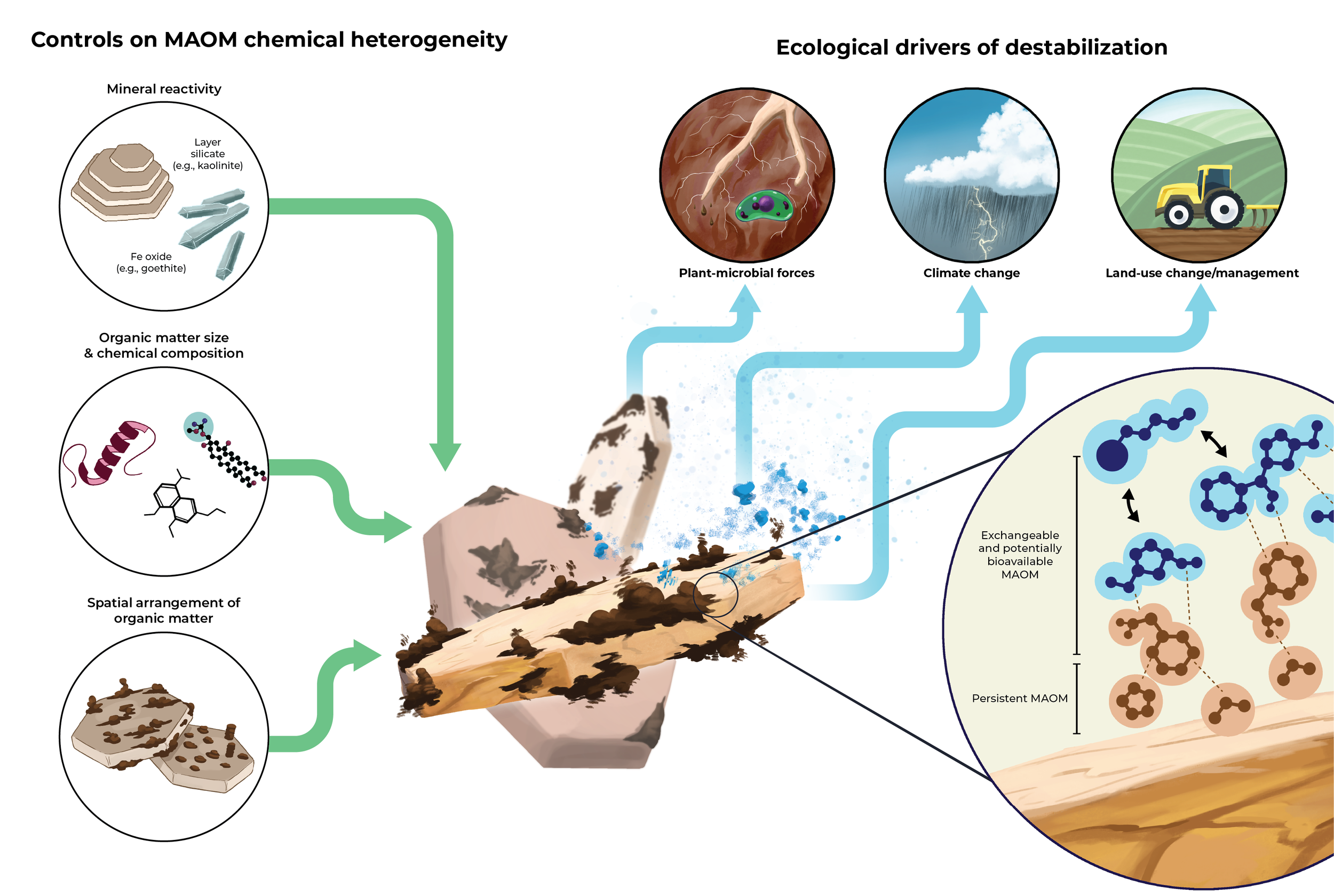Current Research
Characterizing and quantifying the dynamic qualities of mineral-associated organic matter
The majority of soil carbon and nitrogen is held in association with silt and clay particles in a pool known as mineral-associated organic matter (MAOM). Strong physico-chemical interactions between mineral surfaces and organic compounds restrict MAOM decomposition, allowing carbon and nitrogen bound therein to persist in soil for as long as centuries to millennia. However, MAOM is a chemically and functionally diverse pool with a substantial portion cycling at relatively fast timescales. We are conducting research to characterize and quantify this more dynamic and fast-cycling portion of MAOM.
Conceptual figure illustrating the controls on mineral-associated organic matter heterogeneity and and three known drivers of its destabilization. Figure from Jilling et al. (2025) Commun Earth Environ https://doi.org/10.1038/s43247-025-02681-8
The role of plant-microbe-mineral interactions in the carbon and nitrogen cycles
Plant-soil interactions influence the nitrogen supply from soil to plant, but these feedbacks are often excluded from conventional approaches to measuring and predicting soil N availability. The presence of an active plant root in the soil can dramatically alter soil organic matter turnover dynamics. In particular, active roots can influence the rhizosphere such that it is biologically and chemically distinct from bulk soil environments. This effect is driven by the root-deposited compounds, known as exudates, such as carbohydrates, organic acids, and amino acids. We are interested in how exudates influence the formation and turnover of soil carbon and nitrogen within soil organic matter fractions, with a particular focus on mineral-associated organic matter. We employ 13C and 15N-based techniques to examine the influence of plant-microbe-mineral interactions on soil nitrogen supply and soil health.
View past publications in this area:
https://rdcu.be/eC4s0
https://doi.org/10.1016/j.soilbio.2021.108265
https://doi.org/10.1016/j.geoderma.2024.116869
Methods comparison of soil organic matter fractionation procedures
Fractionation methods are a standard procedure for isolating distinct pools of soil organic matter in order to understand a soil’s carbon storage and nutrient supply capacity. Decades of research in this area has produced a range of methods in which soil organic matter can be separated physically or chemically, and using a variety of dispersion techniques.
Carbon and nitrogen dynamics in organic matter fractions under varying management regimes
Relevant publication: https://doi.org/10.1016/j.geoderma.2019.114001
The distribution of carbon and nitrogen across soil organic matter fractions serves as an indicator for the nutrient-providing capacity of agricultural soils. Mineral-associated organic matter stores the majority of soil carbon and nitrogen and may strongly influence ecosystem productivity; how management influences the quantity, chemistry, and agronomic relevance of organic matter fractions remains under-explored. With support from USDA, we are investigating how soil health management practices, such as reduced tillage and cover crops, influence the nutrient storage and supply-potential of soil organic matter in soils of the Southern Great Plains.



